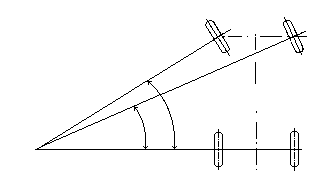
Many circle track racers are becoming aware of Ackerman Steering geometry and are concerned with how it influences their race cars. Conventional Ackerman Steering was developed around 1800 AD. Yes, 1800, not 1900. The Ackerman concept is to have all four wheels rolling around a common point during a turn.

The example above shows that the inside front tire must turn a larger number of degrees than the outside front tire for this principle to work.
Most short tracks (oval tracks) have a corner radius of 150'+/-. For a race car that has a 108" wheel base and 60" width, the inside tire would need to turn 3.4 degrees and the outside tire would need to turn 3.3 degrees to have Ackerman Steering. In other words, the inside tire needs to turn 1/10th of a degree more than the outside tire in order to fulfill the Ackerman requirement for this car and corner.
However, at racing speeds, tires develop what is known as slip angle. Despite the name "slip angle" it has nothing to do with slipping or sliding. Instead, it describes the flexing or twisting of the tire's contact patch. It's not unusual for racing tires to develop 6 +/- degrees of slip angle before they loose traction. DOT (street) tires can develop as much as 10 degrees of slip angle before they loose traction.
Due to the magnitude of flex (slip angle) in the tires, that tenth of a degree steering difference mentioned earlier is negligible. So, when it comes to tuning your race car, take conventional (stock) Ackerman off the list of concerns. However, adjustable (slotted) spindles that allow additional amount of Ackerman can make a big improvement in handling. For more information related to this subject see Slip Angles and Handling.
Alignment shops and some Dealerships will refer to Ackerman as "toe-out." This is because Ackerman steering geometry causes the wheels to toe-out during a sharp turn. Be careful not to confuse this terminology with static toe-out. For more information on toe-out see Toe-out and Handling.